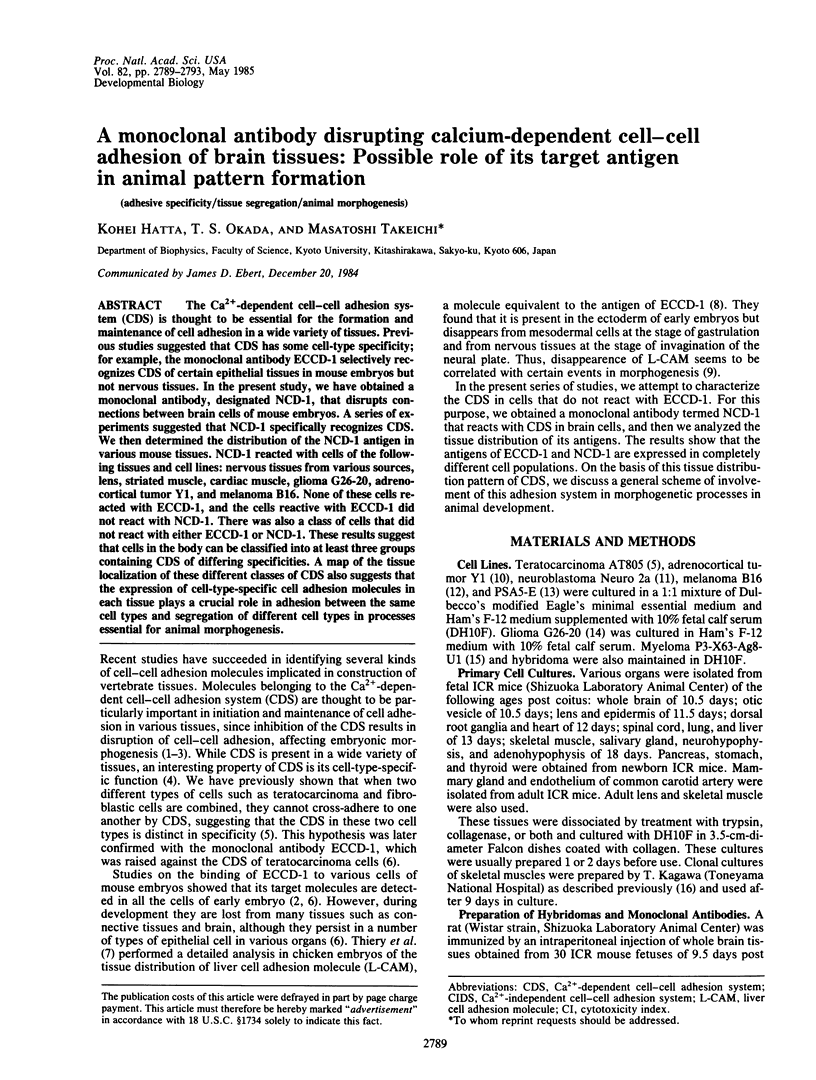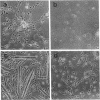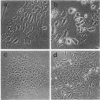Abstract
The Ca2+-dependent cell-cell adhesion system (CDS) is thought to be essential for the formation and maintenance of cell adhesion in a wide variety of tissues. Previous studies suggested that CDS has some cell-type specificity; for example, the monoclonal antibody ECCD-1 selectively recognizes CDS of certain epithelial tissues in mouse embryos but not nervous tissues. In the present study, we have obtained a monoclonal antibody, designated NCD-1, that disrupts connections between brain cells of mouse embryos. A series of experiments suggested that NCD-1 specifically recognizes CDS. We then determined the distribution of the NCD-1 antigen in various mouse tissues. NCD-1 reacted with cells of the following tissues and cell lines: nervous tissues from various sources, lens, striated muscle, cardiac muscle, glioma G26-20, adrenocortical tumor Y1, and melanoma B16. None of these cells reacted with ECCD-1, and the cells reactive with ECCD-1 did not react with NCD-1. There was also a class of cells that did not react with either ECCD-1 or NCD-1. These results suggest that cells in the body can be classified into at least three groups containing CDS of differing specificities. A map of the tissue localization of these different classes of CDS also suggests that the expression of cell-type-specific cell adhesion molecules in each tissue plays a crucial role in adhesion between the same cell types and segregation of different cell types in processes essential for animal morphogenesis.
Full text
PDF




Images in this article
Selected References
These references are in PubMed. This may not be the complete list of references from this article.
- Adamson E. D., Evans M. J., Magrane G. G. Biochemical markers of the progress of differentiation in cloned teratocarcinoma cell lines. Eur J Biochem. 1977 Oct 3;79(2):607–615. doi: 10.1111/j.1432-1033.1977.tb11845.x. [DOI] [PubMed] [Google Scholar]
- Brackenbury R., Rutishauser U., Edelman G. M. Distinct calcium-independent and calcium-dependent adhesion systems of chicken embryo cells. Proc Natl Acad Sci U S A. 1981 Jan;78(1):387–391. doi: 10.1073/pnas.78.1.387. [DOI] [PMC free article] [PubMed] [Google Scholar]
- Damsky C. H., Richa J., Solter D., Knudsen K., Buck C. A. Identification and purification of a cell surface glycoprotein mediating intercellular adhesion in embryonic and adult tissue. Cell. 1983 Sep;34(2):455–466. doi: 10.1016/0092-8674(83)90379-3. [DOI] [PubMed] [Google Scholar]
- Edelman G. M. Cell adhesion and morphogenesis: the regulator hypothesis. Proc Natl Acad Sci U S A. 1984 Mar;81(5):1460–1464. doi: 10.1073/pnas.81.5.1460. [DOI] [PMC free article] [PubMed] [Google Scholar]
- Fidler I. J. Selection of successive tumour lines for metastasis. Nat New Biol. 1973 Apr 4;242(118):148–149. doi: 10.1038/newbio242148a0. [DOI] [PubMed] [Google Scholar]
- Gallin W. J., Edelman G. M., Cunningham B. A. Characterization of L-CAM, a major cell adhesion molecule from embryonic liver cells. Proc Natl Acad Sci U S A. 1983 Feb;80(4):1038–1042. doi: 10.1073/pnas.80.4.1038. [DOI] [PMC free article] [PubMed] [Google Scholar]
- Grumet M., Hoffman S., Edelman G. M. Two antigenically related neuronal cell adhesion molecules of different specificities mediate neuron-neuron and neuron-glia adhesion. Proc Natl Acad Sci U S A. 1984 Jan;81(1):267–271. doi: 10.1073/pnas.81.1.267. [DOI] [PMC free article] [PubMed] [Google Scholar]
- Grunwald G. B., Bromberg R. E., Crowley N. J., Lilien J. Enzymatic dissection of embryonic cell adhesive mechanisms. II. Developmental regulation of an endogenous adhesive system in the chick neural retina. Dev Biol. 1981 Sep;86(2):327–338. doi: 10.1016/0012-1606(81)90190-1. [DOI] [PubMed] [Google Scholar]
- Grunwald G. B., Pratt R. S., Lilien J. Enzymic dissection of embryonic cell adhesive mechanisms. III. Immunological identification of a component of the calcium-dependent adhesive system of embryonic chick neural retina cells. J Cell Sci. 1982 Jun;55:69–83. doi: 10.1242/jcs.55.1.69. [DOI] [PubMed] [Google Scholar]
- Hoffman S., Sorkin B. C., White P. C., Brackenbury R., Mailhammer R., Rutishauser U., Cunningham B. A., Edelman G. M. Chemical characterization of a neural cell adhesion molecule purified from embryonic brain membranes. J Biol Chem. 1982 Jul 10;257(13):7720–7729. [PubMed] [Google Scholar]
- Magnani J. L., Thomas W. A., Steinberg M. S. Two distinct adhesion mechanisms in embryonic neural retina cells. I. A kinetic analysis. Dev Biol. 1981 Jan 15;81(1):96–105. doi: 10.1016/0012-1606(81)90351-1. [DOI] [PubMed] [Google Scholar]
- Murakami H., Masui H., Sato G. H., Sueoka N., Chow T. P., Kano-Sueoka T. Growth of hybridoma cells in serum-free medium: ethanolamine is an essential component. Proc Natl Acad Sci U S A. 1982 Feb;79(4):1158–1162. doi: 10.1073/pnas.79.4.1158. [DOI] [PMC free article] [PubMed] [Google Scholar]
- Ogou S. I., Yoshida-Noro C., Takeichi M. Calcium-dependent cell-cell adhesion molecules common to hepatocytes and teratocarcinoma stem cells. J Cell Biol. 1983 Sep;97(3):944–948. doi: 10.1083/jcb.97.3.944. [DOI] [PMC free article] [PubMed] [Google Scholar]
- Ogou S., Okada T. S., Takeichi M. Cleavage stage mouse embryos share a common cell adhesion system with teratocarcinoma cells. Dev Biol. 1982 Aug;92(2):521–528. doi: 10.1016/0012-1606(82)90196-8. [DOI] [PubMed] [Google Scholar]
- Peyriéras N., Hyafil F., Louvard D., Ploegh H. L., Jacob F. Uvomorulin: a nonintegral membrane protein of early mouse embryo. Proc Natl Acad Sci U S A. 1983 Oct;80(20):6274–6277. doi: 10.1073/pnas.80.20.6274. [DOI] [PMC free article] [PubMed] [Google Scholar]
- Rathjen F. G., Rutishauser U. Comparison of two cell surface molecules involved in neural cell adhesion. EMBO J. 1984 Feb;3(2):461–465. doi: 10.1002/j.1460-2075.1984.tb01828.x. [DOI] [PMC free article] [PubMed] [Google Scholar]
- Rathjen F. G., Schachner M. Immunocytological and biochemical characterization of a new neuronal cell surface component (L1 antigen) which is involved in cell adhesion. EMBO J. 1984 Jan;3(1):1–10. doi: 10.1002/j.1460-2075.1984.tb01753.x. [DOI] [PMC free article] [PubMed] [Google Scholar]
- Shirayoshi Y., Okada T. S., Takeichi M. The calcium-dependent cell-cell adhesion system regulates inner cell mass formation and cell surface polarization in early mouse development. Cell. 1983 Dec;35(3 Pt 2):631–638. doi: 10.1016/0092-8674(83)90095-8. [DOI] [PubMed] [Google Scholar]
- Sundarraj N., Schachner M., Pfeiffer S. E. Biochemically differentiated mouse glial lines carrying a nervous system specific cell surface antigen (NS-1). Proc Natl Acad Sci U S A. 1975 May;72(5):1927–1931. doi: 10.1073/pnas.72.5.1927. [DOI] [PMC free article] [PubMed] [Google Scholar]
- Takeichi M., Atsumi T., Yoshida C., Uno K., Okada T. S. Selective adhesion of embryonal carcinoma cells and differentiated cells by Ca2+-dependent sites. Dev Biol. 1981 Oct 30;87(2):340–350. doi: 10.1016/0012-1606(81)90157-3. [DOI] [PubMed] [Google Scholar]
- Takeichi M., Ozaki H. S., Tokunaga K., Okada T. S. Experimental manipulation of cell surface to affect cellular recognition mechanisms. Dev Biol. 1979 May;70(1):195–205. doi: 10.1016/0012-1606(79)90016-2. [DOI] [PubMed] [Google Scholar]
- Thiery J. P., Delouvée A., Gallin W. J., Cunningham B. A., Edelman G. M. Ontogenetic expression of cell adhesion molecules: L-CAM is found in epithelia derived from the three primary germ layers. Dev Biol. 1984 Mar;102(1):61–78. doi: 10.1016/0012-1606(84)90175-1. [DOI] [PubMed] [Google Scholar]
- Thiery J. P., Duband J. L., Rutishauser U., Edelman G. M. Cell adhesion molecules in early chicken embryogenesis. Proc Natl Acad Sci U S A. 1982 Nov;79(21):6737–6741. doi: 10.1073/pnas.79.21.6737. [DOI] [PMC free article] [PubMed] [Google Scholar]
- Urushihara H., Ozaki H. S., Takeichi M. Immunological detection of cell surface components related with aggregation of Chinese hamster and chick embryonic cells. Dev Biol. 1979 May;70(1):206–216. doi: 10.1016/0012-1606(79)90017-4. [DOI] [PubMed] [Google Scholar]
- Vestweber D., Kemler R. Rabbit antiserum against a purified surface glycoprotein decompacts mouse preimplantation embryos and reacts with specific adult tissues. Exp Cell Res. 1984 May;152(1):169–178. doi: 10.1016/0014-4827(84)90241-6. [DOI] [PubMed] [Google Scholar]
- Yasumura Y., Buonassisi V., Sato G. Clonal analysis of differentiated function in animal cell cultures. I. Possible correlated maintenance of differentiated function and the diploid karyotype. Cancer Res. 1966 Mar;26(3):529–535. [PubMed] [Google Scholar]
- Yelton D. E., Diamond B. A., Kwan S. P., Scharff M. D. Fusion of mouse myeloma and spleen cells. Curr Top Microbiol Immunol. 1978;81:1–7. doi: 10.1007/978-3-642-67448-8_1. [DOI] [PubMed] [Google Scholar]
- Yoshida-Noro C., Suzuki N., Takeichi M. Molecular nature of the calcium-dependent cell-cell adhesion system in mouse teratocarcinoma and embryonic cells studied with a monoclonal antibody. Dev Biol. 1984 Jan;101(1):19–27. doi: 10.1016/0012-1606(84)90112-x. [DOI] [PubMed] [Google Scholar]





